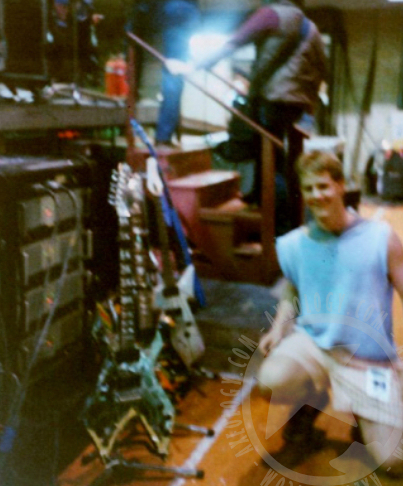
For one reason or another Paul seems to have grown slightly dissatisfied with his PS10's as the Return of KISS Tour wore on. For the first few months his iconic PS10 SM#1 and two "standard" PS10's were the guitars of choice but sometime in October that changed. SM#1 was still the clear-cut first choice but instead of the PS10 backups there appeared the Gibson Explorer II and then, come November, two custom Hamer Standards joined the ranks.
Hamer had been started by Paul Hamer and Jol Dantzig in the early 70's. Originally the pair started a regular music store, Northern Prairie Music which opened in 1973, that specialized in buying old guitars (and banjos) and restoring them for re-sale; for all intents and purposes a vintage guitar store. The pair ventured into guitar construction after seeing the prices that pre-Norlin Gibsons were fetching. "When we created Hamer, we created the high-end boutique guitar category, but we didn't intend it that way. We were seeing vintage '50s Les Pauls selling for $3,000. We thought we could make guitars just as good and sell them for a third of that price." (Vintage Guitar, June 2000) Paul's first use of the custom Hamer Standard seems to be November 6 in Anaheim, CA. According to Hamer (personal communication, 2007), all of Paul's Hamers were specifically built for him and comparing them to the regular models we see several things that differ. As seen in the pic here there are two small "indentations", one on the upper bout and one on the treble horn. Unlike the "standard" Standard, Paul's also has a three-a-side headstock and in place of the tune-o-matic-style bridge was the Sustain Block bridge used on the Hamer Sunburst. (This was something that other Standards that left Hamer had but the main bridge type of the Standard was the fine-tune bridge with a stop tailpiece.) Binding of the neck, as seen on Paul's guitars, was an option of the Standard but the inlays were not. The inlays on Paul's custom Hamers, and this goes for all of them, were more or less a copy of the ones on the PS10 with a pearl square split by an abalone line in the center. The Hamer inlays only differ in the width of the abalone line which is narrower and the fact that the 12th fret inlay only features one abalone split (the PS10 had two).
Hamer had been started by Paul Hamer and Jol Dantzig in the early 70's. Originally the pair started a regular music store, Northern Prairie Music which opened in 1973, that specialized in buying old guitars (and banjos) and restoring them for re-sale; for all intents and purposes a vintage guitar store. The pair ventured into guitar construction after seeing the prices that pre-Norlin Gibsons were fetching. "When we created Hamer, we created the high-end boutique guitar category, but we didn't intend it that way. We were seeing vintage '50s Les Pauls selling for $3,000. We thought we could make guitars just as good and sell them for a third of that price." (Vintage Guitar, June 2000) Paul's first use of the custom Hamer Standard seems to be November 6 in Anaheim, CA. According to Hamer (personal communication, 2007), all of Paul's Hamers were specifically built for him and comparing them to the regular models we see several things that differ. As seen in the pic here there are two small "indentations", one on the upper bout and one on the treble horn. Unlike the "standard" Standard, Paul's also has a three-a-side headstock and in place of the tune-o-matic-style bridge was the Sustain Block bridge used on the Hamer Sunburst. (This was something that other Standards that left Hamer had but the main bridge type of the Standard was the fine-tune bridge with a stop tailpiece.) Binding of the neck, as seen on Paul's guitars, was an option of the Standard but the inlays were not. The inlays on Paul's custom Hamers, and this goes for all of them, were more or less a copy of the ones on the PS10 with a pearl square split by an abalone line in the center. The Hamer inlays only differ in the width of the abalone line which is narrower and the fact that the 12th fret inlay only features one abalone split (the PS10 had two).
[Above] Hamer Standard custom with some distinctive features, most notably the minor changes to the body shape and the Sustain Block bridge.
Last but not least, Paul's Standards have the toggle switch in the Les Paul position on the upper bout rather than on the treble horn. Construction-wise it's unlikely that the custom Standards differed much from Hamers usual woods since Paul was a fan of the classic mahogany body with a set mahogany neck (Hamer used British Honduras mahogany). According to the 1980 Sounds interview the custom Standards also featured "the heaviest frets I could get and an ebony fingerboard". Judging by the available pics there were two custom Standards that showed up for the tail end of the Return of KISS Tour. They share the same basic look - the custom shape, body and neck binding, Sustain Block bridge, split inlays, and three-a-side headstock - and only differ in the pickup rings. The first one as seen above, which seems to have been his first choice of the Hamers at the time, had black pickup rings, and the second one (as pictured here on the left) had chrome pickup rings. The June 2000 issue of Vintage Guitar mentioned above features a list of Hamer customers, unfortunately undated but estimated to be from late '78 to early '80, and it lists Paul as the recipient of three custom Standards. Pictures from 1979, and even 1980, only seems to reveal two and Paul himself, again in the 1980 Sounds interview, only mentions two.
This "minor variation" trick with the pickup ring seems to be a way for Paul and his tech to easily tell guitars apart. Recall the pickup ring and lack thereof of the mirror pickguard Gibson Flying V's, the subtle differences in the PS10 prototypes, and the different tuning pegs of the backup PS10's for the Return of KISS Tour.
This "minor variation" trick with the pickup ring seems to be a way for Paul and his tech to easily tell guitars apart. Recall the pickup ring and lack thereof of the mirror pickguard Gibson Flying V's, the subtle differences in the PS10 prototypes, and the different tuning pegs of the backup PS10's for the Return of KISS Tour.
After PS10 SM#2 got its due as the "poster child" for the Unmasked World Tour the custom Hamers took over. For Eric's inaugural show at the Palladium on July 25 Paul used both custom Standards but #2 from the previous tour, which had the chrome pickup rings, had gotten a modification in the shape of a custom flame-shaped mirror pickguard. Both Standards had also gotten new pickups. The Standard, at the time, came with DiMarzio PAF-style pickups that later became known as the Hamer Slammer so, being a fan of DiMarzios, it's not entirely unlikely that Paul tried those out when he first received his Standards. Pictures from the Return of KISS Tour all show the Standards with non-descript humbuckers with visible pole pieces. Come 1980 Paul seemed to transfer his pickup allegiance to EMG's almost exclusively (see PS10 SM#2 for instance). "When I tried some EMGs out, they really sounded good in the guitars I was using at that point, so I switched. I think the time I started using EMGs were in some Hamer guitars I had made, I'd say in the early '80s." (Vintage Guitar, March 1997) Both Standards were outfitted with EMG's and considering the time they were probably Overlend EMG-H, as seen in Stockholm, Sweden on October 8 they lack the small white (or silver) EMG logo, so they probably have the old Overlend relief logo. (Some of the photos by Pete Still from London, England seem to show the relief logo but it is very hard to spot since it's a black-on-black relief.)
These two custom Standards, I'll just call them black (#1) and flame (#2) because I can, are the main guitars for the entire Unmasked Tour.
These two custom Standards, I'll just call them black (#1) and flame (#2) because I can, are the main guitars for the entire Unmasked Tour.
During the Unmasked World Tour Paul expanded his stable of Hamers further, first with a maroon Flying V. The Flying V shape from Hamer was known as the Vector and although Paul's V was obviously custom made I've decided to refer to it as a custom Vector. Officially introduced as a special order in 1981, the Vector had all the specs Paul appreciated - mahogany body with a set mahogany neck and an optional maple top. Paul's custom Vector differed in that it had binding on both the body and the neck (the regular Vector had neither), "his" three-piece block inlays, EMG pickups, a mirror pickguard, the output jack at the very end of the lower wing, and, curiously, a longer headstock that matched the headstock of his custom Standards. The custom Vector seems to have been used mainly for certain songs. The picture here shows it with a capo on the 2nd fret for Is That You?, a role it also has in the video from Melbourne, Australia on November 22 (consult your KISSology vol. 2). It was also used for Shandi (capo at the 4th fret) and, as can also be seen in the Melbourne footage, un-capoed for I Was Made For Lovin' You. It shows up for the first time at the Palladium on July 25 and doesn't last past the Unmasked Tour.

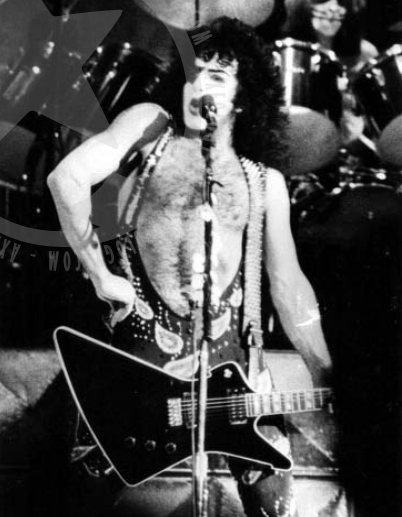

[Left] Hamer Standard custom #2 had the same basic specs but featured chrome pickup rings.

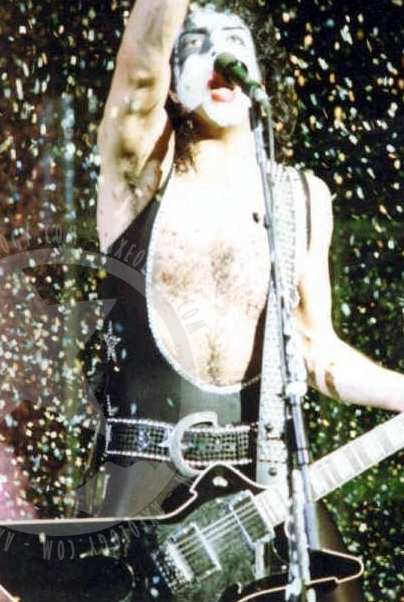
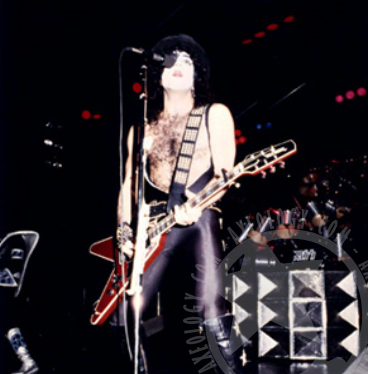
[Right] Everything's cooler with flames. The chrome-pickup ring Hamer Standard custom (#2 as I call it) in its new guise with EMG pickups and a flame mirror pickguard.
Paul also had a custom Hamer doubleneck made at this time. When it was part of the Convention Museum it was described as a "one-of-a-kind custom Hamer doubleneck guitar designed by Paul Stanley" but how much of it, if any, was actually designed by Paul is unknown. The body of the guitar is basically just a twin-neck version of the Hamer Special but with the neck closer than customary (which probably created the slightly odd headstock shape, it was a necessity so that the tuners would fit). The skeptic in me tends to believe that Paul's contribution was probably limited to the mirror pickguards that have a striking resemblance to Gene's makeup design. As far as I know this guitar was used very little during the tour, and what use it got was late in the tour: there are live photos from Brisbane, Australia and Wellington, New Zealand (right), one photo that appears to have been shot in a hotel room, and a studio photo possibly taken during overdubs for the Inner Sanctum special. Most revealing is the news footage from Wellington which has a few seconds of Detroit Rock City and show Paul playing this doubleneck. It has the capo on the top neck so logic suggests that it was used for the first four songs of the show (Shandi being the fourth song).
Paul's name is included in promotional material from Hamer from 1983. In a rather illustrious list of names who have purchased Hamer instruments (no giveaways here), Paul is listed as having bought three Standards and one doubleneck. Not only does this overlook the custom Vector above, it also neglects to mention another custom Vector (see below) which has to call into question the records kept at Hamer in the late 70's and early 80's.
Paul's name is included in promotional material from Hamer from 1983. In a rather illustrious list of names who have purchased Hamer instruments (no giveaways here), Paul is listed as having bought three Standards and one doubleneck. Not only does this overlook the custom Vector above, it also neglects to mention another custom Vector (see below) which has to call into question the records kept at Hamer in the late 70's and early 80's.
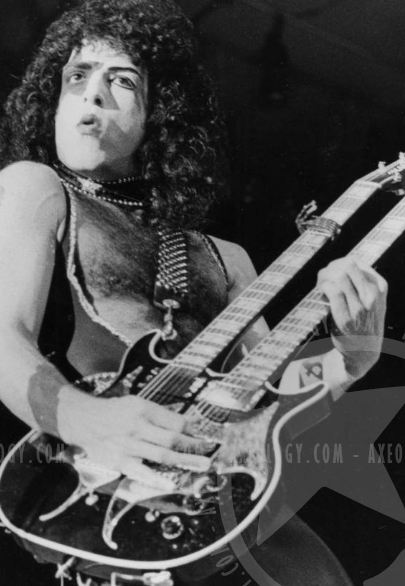


[Right] The Hamer custom doubleneck with its twin mirror pickguards bearing a striking resemblance to Gene's makup design. Coincidence?

For the few performances and video shoots that the band actually did in support of Music from the Elder Paul had a brand-new Hamer in tow. When visiting Mexico in September, and fittingly enough not playing a single song from the yet-to-be-released new album, Paul used his Carr Star and a brand new custom Hamer Vector. The guitar once again differs quite a lot from a standard Vector but has many of the same features as his previous maroon custom Vector: binding on the body, the three-piece pearl/abalone block inlays, a metal-like pickguard, and a non-standard placement of the output jack. (The classic V ornament below the bridge is probably a homage to the earliest Flying V's. This feature wasn't found on Vectors at the time.) One very distinct feature of the white Vector is the headstock which is short, very pointy, and resembles nothing else that Hamer produced at the time.
The standard Vector had the three-way switch located below the bridge but above the controls while the output jack was in line with the relatively narrowly spaced control knobs. For the maroon Vector Paul had the switch in more or less the "standard" position, it's just slightly further down the wing, but the output jack was moved all the way to the end of the lower wing. (See the Melbourne, Australia video of Is that you? for a nice shot of Paul plugging in to see what I mean.) The white Vector, as shown on the left, had the three-way switch located in line with the contol knobs, where the output jack was normally located, while the output jack had been moved to the inside of the lower wing.
After having been baptized on Mexican television the white Vector was featured in the video for A World without heroes which was recorded over Haloween weekend 1981. It was also used for the taping of the scrapped video for I at the same time. After getting some more airtime on Solid Gold in November it was passed over for the actual playing performance on Fridays on January 15, 1982.
The standard Vector had the three-way switch located below the bridge but above the controls while the output jack was in line with the relatively narrowly spaced control knobs. For the maroon Vector Paul had the switch in more or less the "standard" position, it's just slightly further down the wing, but the output jack was moved all the way to the end of the lower wing. (See the Melbourne, Australia video of Is that you? for a nice shot of Paul plugging in to see what I mean.) The white Vector, as shown on the left, had the three-way switch located in line with the contol knobs, where the output jack was normally located, while the output jack had been moved to the inside of the lower wing.
After having been baptized on Mexican television the white Vector was featured in the video for A World without heroes which was recorded over Haloween weekend 1981. It was also used for the taping of the scrapped video for I at the same time. After getting some more airtime on Solid Gold in November it was passed over for the actual playing performance on Fridays on January 15, 1982.
For the lone live performance in support of The Elder on the TV show Fridays, Paul chose to bring out his black (#1) Hamer Standard custom again. I find this decision slightly perplexing. Everything else they did in "support" of The Elder featured the white Vector; it was, for all intents and purposes, as much part of the re-imagined KISS as the new costumes. It was a type of guitar that he'd played before for the entire Unmasked Tour and considering how much use it got during the subsequent tours it was obviously a guitar he cherished and liked to play. So why was it put aside for the only live recording and then brought out again for the playback "performance" for the San Remo Festival on January 28?
This is pure speculation but I think the band, and therefore Paul, were nervous. They had gotten some limited critical acclaim that they had coveted but in return album sales had plummeted. Tour plans were still in the works but the original budget from October 1981 was being reworked and finances looked less than promising. (KISS Alive Forever, p. 117) That made the Fridays performance much more important than it probably should have been since it became a kind of showcase for a prospective tour, and with the pressure of putting on a "good show" Paul might have felt that adding an unknown variable was a bit too much. It was probably much more comfortable to bring out a trusted guitar that had logged 50+ shows over the past two tours.
This is pure speculation but I think the band, and therefore Paul, were nervous. They had gotten some limited critical acclaim that they had coveted but in return album sales had plummeted. Tour plans were still in the works but the original budget from October 1981 was being reworked and finances looked less than promising. (KISS Alive Forever, p. 117) That made the Fridays performance much more important than it probably should have been since it became a kind of showcase for a prospective tour, and with the pressure of putting on a "good show" Paul might have felt that adding an unknown variable was a bit too much. It was probably much more comfortable to bring out a trusted guitar that had logged 50+ shows over the past two tours.
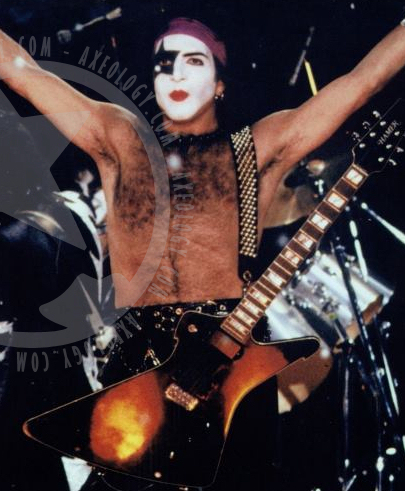



With a new album in the bag and hoping to distance themselves from the relative failure of The Elder the band tried to "re-invent" their look a little. The costumes were more 70's KISS than Super-KISS or the "new wave" KISS of The Elder. Paul also decided to let the album title dictate the look of his guitars: black was pretty much out, animal print was in. The promotional appearances and the photo shoots during the fall/winter of 1982 were dominated by the newly acquired B.C. Rich Eagle but when it came time to hit the stage for the 10th Anniversary Tour the Hamer Vector, now re-finished in handsome zebra stripes, seems to be the #1 darling.
Apart from the paint job, which extends to the headstock that is now black, there are a few more changes. Most obvious is the new pickguard that is partially translucent plastic that allows the zebra stripes to "shine through". Less obvious, and actually a return to the original, is the placement of the strap button on the inside of the upper wing as seen in the picture on the left. This strap button was removed when the guitar was white and a screw-in loop was added right in the angle where the wings meet. Scroll up half a page and the October 31 pic shows this very clearly, you can even see the hole where the original strap button has been removed. Lastly, the ornamental V below the bridge has been removed.
As mentioned, the Zebra Vector appears to be the favorite for the better part of the tour. In the video from Montreal, Canada on January 13, 1983 Paul opens the show with the B.C. Rich Eagle (capoed at the 3rd fret for Creatures of the night) but uses the Vector for the rest. In total Paul seems to have traveled with six guitars during this tour and judging by the photos the Vector was #1. It was also the only guitar that wasn't used with a capo for Creatures of the night.
Apart from the paint job, which extends to the headstock that is now black, there are a few more changes. Most obvious is the new pickguard that is partially translucent plastic that allows the zebra stripes to "shine through". Less obvious, and actually a return to the original, is the placement of the strap button on the inside of the upper wing as seen in the picture on the left. This strap button was removed when the guitar was white and a screw-in loop was added right in the angle where the wings meet. Scroll up half a page and the October 31 pic shows this very clearly, you can even see the hole where the original strap button has been removed. Lastly, the ornamental V below the bridge has been removed.
As mentioned, the Zebra Vector appears to be the favorite for the better part of the tour. In the video from Montreal, Canada on January 13, 1983 Paul opens the show with the B.C. Rich Eagle (capoed at the 3rd fret for Creatures of the night) but uses the Vector for the rest. In total Paul seems to have traveled with six guitars during this tour and judging by the photos the Vector was #1. It was also the only guitar that wasn't used with a capo for Creatures of the night.
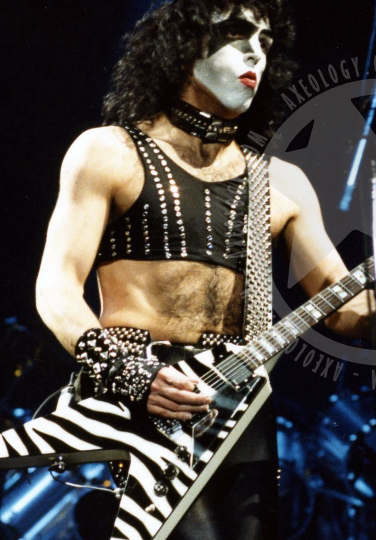
Acompanying the Zebra Vector was a trusted old friend, the #2 Hamer Standard now re-finished to look like a Tiger. That this is indeed #2 is based entirely on the chrome pickup rings. (This guitar was auctioned off and in the Butterfields catalogue it appears as lot 1599 (p. 115) and claimed to have serial no. 0237. Serial numbers of Hamers changed in 1977 with the introduction of the Sunburst. Up until then it had been a simple, sequential 4-number serial system. After 1977 it was a two-part serial where the first, and separate, digit denoted the year of completion and the following 4-5 digit serial denoted the number of the guitar. This type of serial number, however, did not apply to some custom guitars, most notably Standards. Therefore the serial 0237 doesn't say anything of when this guitars was made so it doesn't allow us to say for sure that the Hamer Tiger is indeed the custom #2 Hamer Standard. Suffice to say that the serial no. for the only other Hamer Standard in the Butterfields auction, lot 1136 which I believe to be Hamer Standard #1, is 0292 and that at least suggests that he got both guitars at about the same time.)
The flame mirror pickguard is now gone, never to return, and so are the original speed knobs, replaced by top-hat-like knobs without any print on them. The first time I've spotted it is on January 21 in Portland, MA but the pictures available to me from this tour are reletively few and an even smaller subset are accurately dated. It is perfectly possible that it was along for the ride and used before then. What we can say for sure is that it was used to open the show at least once. All the known setlists from this tour has Creatures of the night as the opener and it is also the only song in the set that featured a capo. The Hamer Tiger (#2 Standard) seems to get used slightly more towards the end of the tour in March. Pics from this latter part of the tour also reveal that the pickups in the Hamers were indeed the early relief logo EMG-H made when they were still called Overlend.
The flame mirror pickguard is now gone, never to return, and so are the original speed knobs, replaced by top-hat-like knobs without any print on them. The first time I've spotted it is on January 21 in Portland, MA but the pictures available to me from this tour are reletively few and an even smaller subset are accurately dated. It is perfectly possible that it was along for the ride and used before then. What we can say for sure is that it was used to open the show at least once. All the known setlists from this tour has Creatures of the night as the opener and it is also the only song in the set that featured a capo. The Hamer Tiger (#2 Standard) seems to get used slightly more towards the end of the tour in March. Pics from this latter part of the tour also reveal that the pickups in the Hamers were indeed the early relief logo EMG-H made when they were still called Overlend.
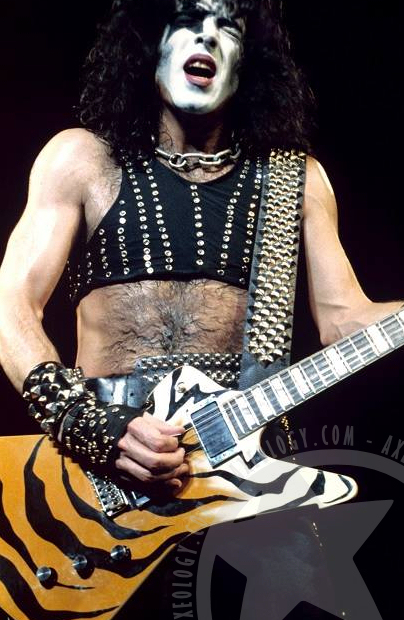
Rounding out the Hamer contribution to the Tour was the custom doubleneck. Much like in 1980 it seems to have handled mainly capo duties, I've yet to come across a photo from this tour where Paul plays the un-capoed neck, and it was probably only used in early 1983. (Again, only Creatures of the night featured a capo and it was the opener. Photos of Paul playing the doubleneck also coincide with Gene wearing his Love Gun boots which he stopped using in early February; I've first spotted the "spiky" boots on February 18 in Minneapolis, MN.)
This guitar ends up in storage after the end of the 10th Anniversary Tour, is brought out for the Convention Tour "museum" as mentioned above, and later auctioned off by Butterfields (lot 1600) as "An original Hamer custom "double neck" electric guitar" in 2000. Interesting to note is that although explicitly stated in the Convention Tour display, the Butterfields lot description makes no mention of any design contribution by Paul.
This guitar ends up in storage after the end of the 10th Anniversary Tour, is brought out for the Convention Tour "museum" as mentioned above, and later auctioned off by Butterfields (lot 1600) as "An original Hamer custom "double neck" electric guitar" in 2000. Interesting to note is that although explicitly stated in the Convention Tour display, the Butterfields lot description makes no mention of any design contribution by Paul.
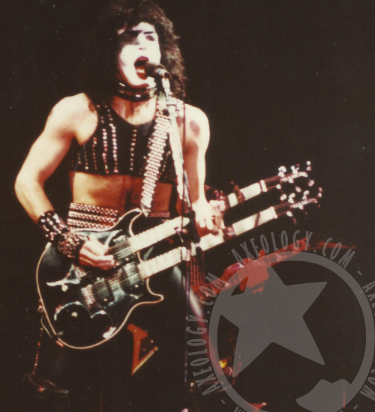
[Left] Hamer Doubleneck on stage during the 10th Anniversary Tour. Capo at the 3rd fret of the top neck suggest it was used for Creatures of the night.
For the Lick It Up tour in Europe Paul again traveled with 6 (!) guitars and although he reached more often for his B.C. Rich Eagles both the Zebra Vector and the Hamer Tiger were used almost every night. Neither of the two seems to have had any alterations done and in the case of the Hamer Tiger that is a bit surprising. All his other guitars at this time had EMG-H pickups with the small white logo (see the photo from London, England 1983-10-23 on the right) but the Hamer Tiger retained the old Overlend EMG-H that were installed in 1980, in fact, it still had them when it was featured in the 1995 Convention Tour Book (see p. 27). In contrast the Zebra Vector had its pickups changed before the 10th Anniversary Tour: when it appeared in its all-white guise in 1981 the Vector featured non-logo active pickups - they had neither the Overlend embossed logo nor the small white EMG logo - but by 1983 it had gotten the then-new EMG-H with the small white logo. Why the Hamer Tiger (Standard #2) didn't have its pickups changed is puzzling.


[Right] The Zebra Vector with white logo EMG-H pickups in London, England 1983-10-23. Photo by Pete Still.
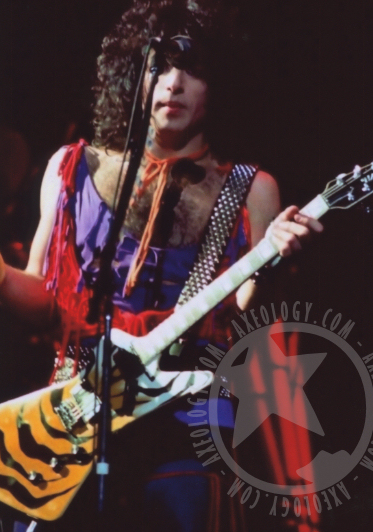
The US leg of the Lick It Up Tour was also to be the swan song of the Hamer Tiger and the Zebra Vector which doesn't make a whole lot of sense when considering that the next tour was very much into animal print. However, the disappearance of these two was probably due to two factors, the most relevant one being that Paul was endorsing B.C. Rich, an endorsement he more or less honored for the next few tours. Second, the Zebra Vector may have developed some problems by early 1984. In several photos from the latter part of the tour when using an angled cable, the cable is secured to the body with a strip of tape. Since this hadn't been an issue earlier in the tour and it wasn't a general precaution, neither of the B.C. Riches got the tape treatment when using angled cables, it's probably fair to say that the Zebra Vector needed some work.
Instead both the Zebra Vector and the Hamer Tiger (Standard #2) were put away and then brought out for the Convention Tour (see p. 26-27 in the tour book). In the Butterfields auction the Zebra Vector is lot 1132 and presented as having serial no. 13777. This denotes that the guitar was built in 1981 (the first digit is the year) and that it was the 3777th guitar numbered according to this system. This, along with the holes left over from moving the strap button, is the best evidence that the white custom Vector Paul had in 1981 was indeed refinished and became the Zebra Vector. The Hamer Tiger was lot 1599.
Instead both the Zebra Vector and the Hamer Tiger (Standard #2) were put away and then brought out for the Convention Tour (see p. 26-27 in the tour book). In the Butterfields auction the Zebra Vector is lot 1132 and presented as having serial no. 13777. This denotes that the guitar was built in 1981 (the first digit is the year) and that it was the 3777th guitar numbered according to this system. This, along with the holes left over from moving the strap button, is the best evidence that the white custom Vector Paul had in 1981 was indeed refinished and became the Zebra Vector. The Hamer Tiger was lot 1599.
And then, Heaven's on fire hit the airwaves and Paul showed up with a brand new Hamer. The Scarab was introduced by Hamer in 1984 in the Hamer Rocks Hard series of pamphlets which featured such luminaries as Judas Priest, Krokus and Def Leppard, and was described as "definitely not for the timid". For all intents and purposes one can consider the Scarab a slimmed-down Standard (the Hamer take on the Explorer shape) with a wave-like cutout at the lower end of the body. It had a dove-tailed set neck with either rosewood or ebony fretboard and inlays were either dot, "crown", or LED. There were two models: the I with a single humbucker or the II with, you guessed it, two humbuckers. Pickups were Hamer Slammers and the bridge was a Kahler Top Mount but being true to their custom shop beginnings Hamer offered various bridge and pickup alternatives.
Paul's Scarab (as seen on the right) wasn't just the result of a few choices of standard options, it was a true custom-built one-of-a-kind guitar. Paul's Scarab had a slightly different body shape with both the lower horn and the upper "bout" having more mass and a more angular appearance; it had a set bridge which appears similar to the Schaller 455; the pickups were EMG 1981; the control layout was completely changed, at least partially to allow for the electronics for the active pickups; and the output jack was in another position. Basically, only the headstock and the LED inlays were part of the standard package of options that Hamer offered.
As for the "finish" it can only be described as a mylar-like sheet that covers the top. When the guitar moves the top reflects and refracts the light which makes it looks a bit like a rainbow at times or simply like a mirror or a sheet of silver at other times. (The effect is very apparent in the Heaven's on fire video.)
Paul's Scarab (as seen on the right) wasn't just the result of a few choices of standard options, it was a true custom-built one-of-a-kind guitar. Paul's Scarab had a slightly different body shape with both the lower horn and the upper "bout" having more mass and a more angular appearance; it had a set bridge which appears similar to the Schaller 455; the pickups were EMG 1981; the control layout was completely changed, at least partially to allow for the electronics for the active pickups; and the output jack was in another position. Basically, only the headstock and the LED inlays were part of the standard package of options that Hamer offered.
As for the "finish" it can only be described as a mylar-like sheet that covers the top. When the guitar moves the top reflects and refracts the light which makes it looks a bit like a rainbow at times or simply like a mirror or a sheet of silver at other times. (The effect is very apparent in the Heaven's on fire video.)

The Scarab was used exclusively for the song Heaven's on fire during both the European and the US part of the tour. The photo on the left is from Paris, France on November 5, the very last date of the European part of the tour and it shows the LED fretboard inlays in action. The photo above and the long-form video Animalize Live Uncensored show the Scarab in action during the US leg. The reason it was used for that particular song was because it was the only song in the set that featured an open-G tuning. (Bruce played his parts in standard tuning and didn't need to change guitars.)
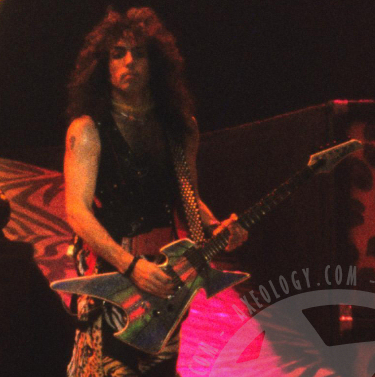

[Left] The Hamer Scarab closing out the European part of the Animalize Tour in Paris. During this show Bon Jovi arranged for a few thousand (!) table tennis balls to be dropped during the KISS show.
The Scarab was used to close out the Animalize Tour (even if the last dated photo I have is from Nashville, TN on January 19) but then it falls out of favor. Once the Asylum Tour starts in November of 1985 the open-G duties have been taken over by the cracked mirror B.C. Rich Warlock and in 1986 the hockey stick headstock Eagle fills the role. I have yet to see a single photo of the Hamer Scarab on stage during the Asylum Tour and it's not in any of the bootleg videos either. However, as the photo on the right shows it was still part of Paul's arsenal. This photo, taken by members of the crew backstage in Hammond, IN on March 30, show the Scarab "at the ready" behind the cracked mirror Warlock and one of the Asylum-striped B.C. Rich Eagles.
After this particular photo I have no idea what happened to the Scarab. It wasn't in the Convention tourbook nor, as far as I can tell from photos or videos, in the Musem part of the Convention in 1995. It wasn't part of the Butterfields auction either.
After this particular photo I have no idea what happened to the Scarab. It wasn't in the Convention tourbook nor, as far as I can tell from photos or videos, in the Musem part of the Convention in 1995. It wasn't part of the Butterfields auction either.
